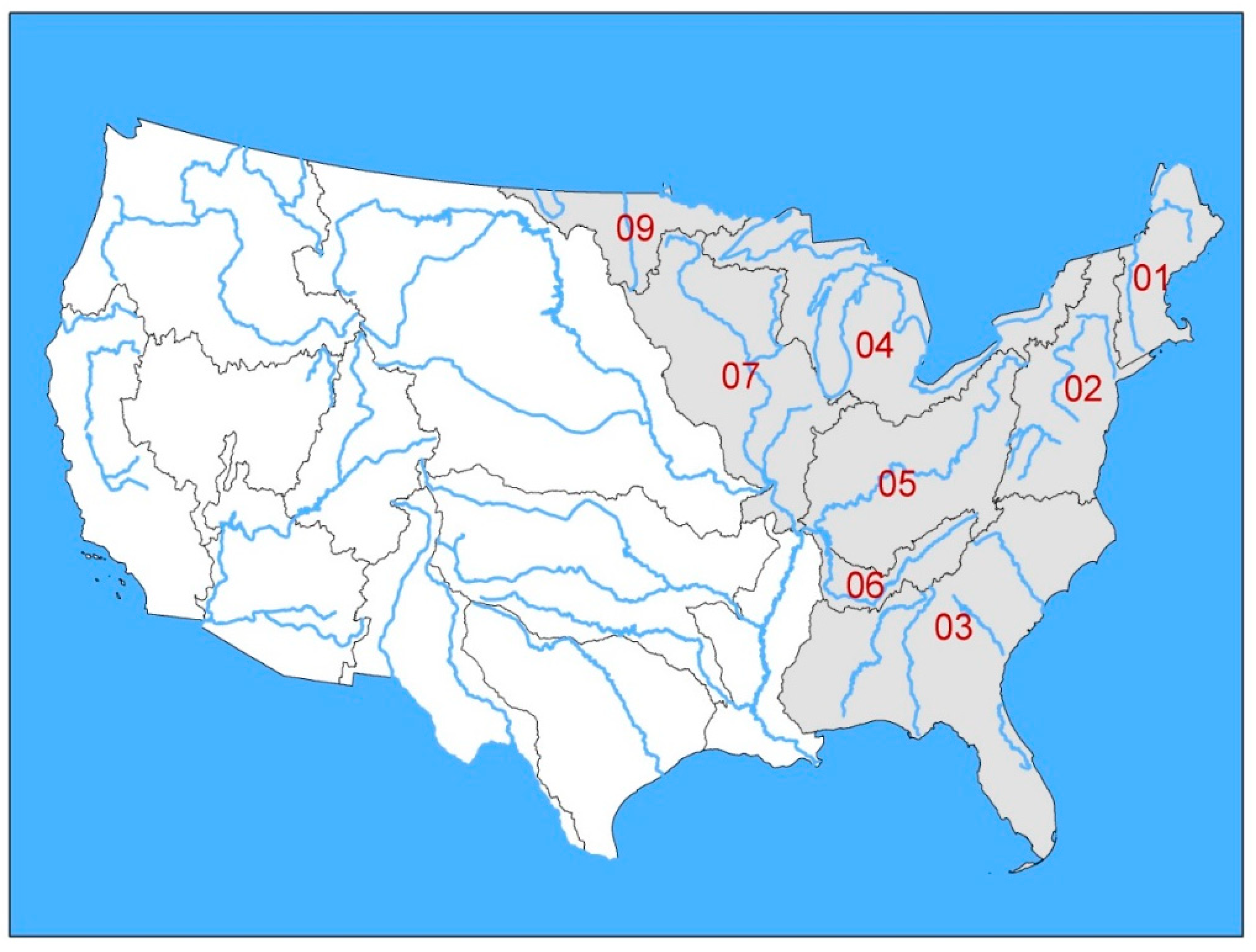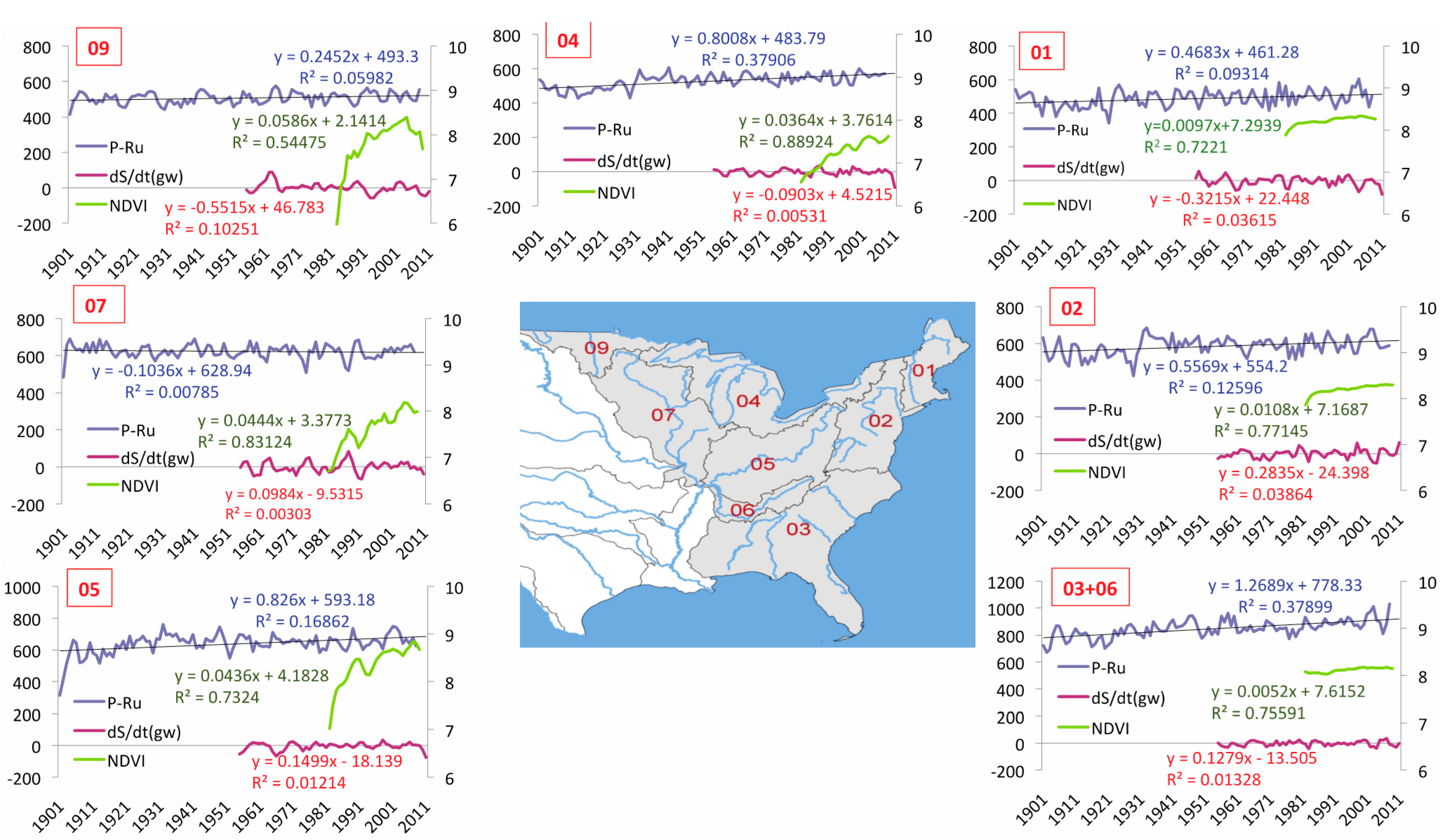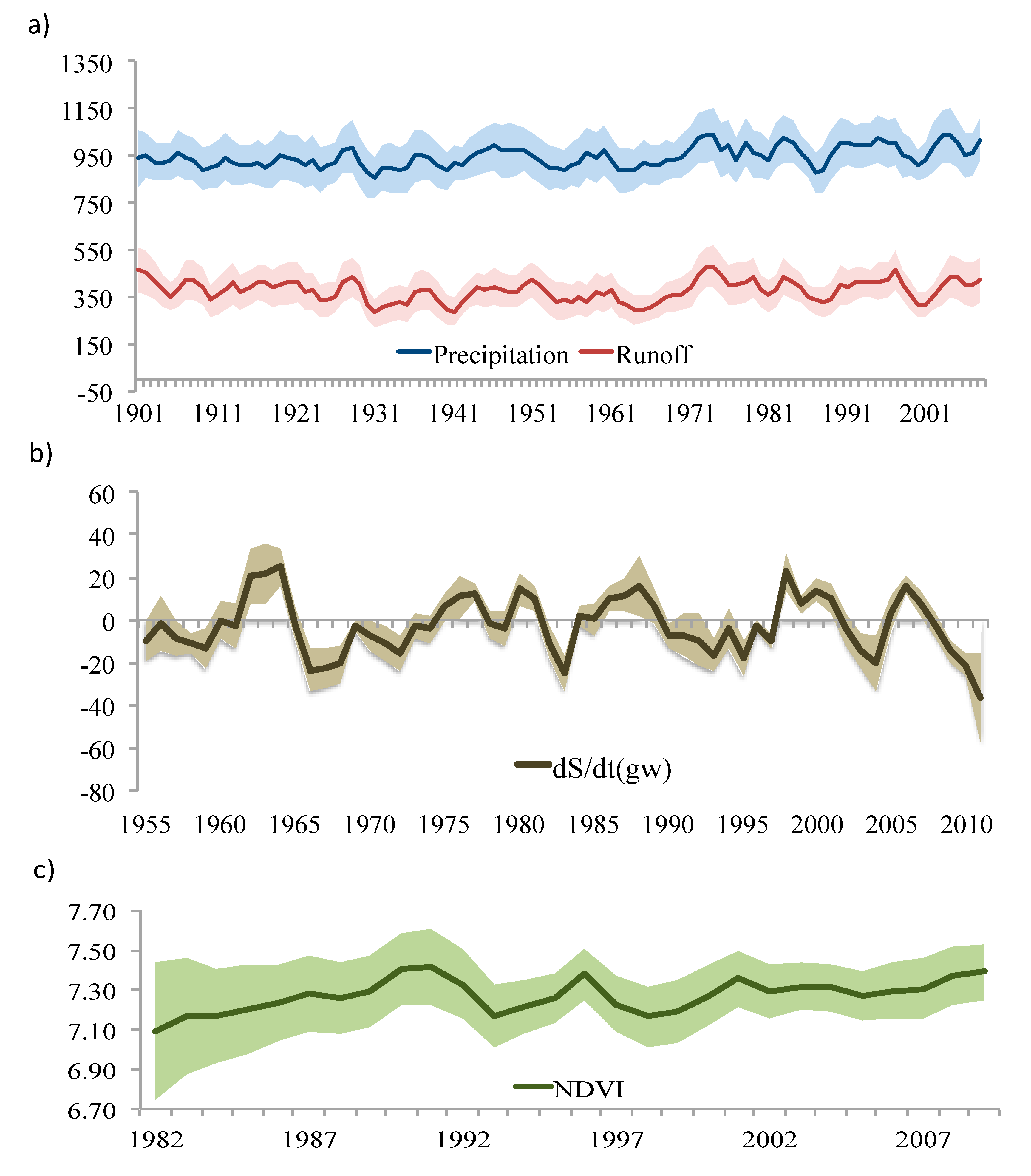Evapotranspiration Trends Over the Eastern United States During the 20th Century
Abstract
:1. Introduction
2. Materials and Methods
2.1. Basin-Scale Water Budget
2.2. Study Area

2.3. Precipitation and Runoff Data
2.4. Groundwater Storage—Water Table Fluctuation Method
2.5. NDVI
2.6. Water Withdrawal Data from the USGS
3. Results and Discussion
3.1. Inter-Hydrological Unit Analysis

| P-Ru | dS/dt(gw) | NDVI | ||||
|---|---|---|---|---|---|---|
| Linear slope | Kendall slope | Linear slope | Kendall slope | Linear slope | Kendall slope | |
| [p-value] | [p-value] | [p-value] | [p-value] | [p-value] | [p-value] | |
| HU01 | 0.47 | 0.43 | −0.31 | −0.22 | 0.01 | 0.01 |
| [0.0013] | [0.0041] | [0.1935] | [0.3182] | [1.91(10)−9] | [7.77(10)−9] | |
| HU02 | 0.56 | 0.52 | 0.25 | 0.3 | 0.01 | 0.01 |
| [0.0002] | [0.0013] | [0.2140] | [0.1464] | [8.59(10)−13] | [2.05(10)−11] | |
| HU03+06 | 1.27 | 1.23 | 0.15 | 0.16 | 0.01 | 0.01 |
| [1.33(10)−12] | [1.96(10)−11] | [0.3474] | [0.4366] | [1.58(10)−9] | [1.40(10)−6] | |
| HU04 | 0.80 | 0.81 | −0.06 | −0.03 | 0.04 | 0.04 |
| [1.33(10)−12] | [6.90(10)−11] | [0.7129] | [0.8096] | [2.97(10)−13] | [4.87(10)−10] | |
| HU05 | 0.83 | 0.56 | 0.07 | 0.04 | 0.04 | 0.04 |
| [1.00(10)−5] | [1.40(10)−3] | [0.7223] | [0.7990] | [9.98(10)−10] | [3.02(10)−9] | |
| HU07 | −0.10 | −0.10 | 0.10 | 0.18 | 0.04 | 0.04 |
| [0.3618] | [0.3250] | [0.6892] | [0.4614] | [7.51(10)−11] | [7.93(10)−9] | |
| HU09 | 0.25 | 0.22 | −0.61 | −0.37 | 0.06 | 0.05 |
| [0.0107] | [0.0180] | [0.0094] | [0.0702] | [1.00(10)−5] | [7.81(10)−7] | |
3.2. Study Region Analysis
3.2.1. Precipitation and Runoff Trends

3.2.2. Groundwater Storage and NDVI Trends
| Linear regression slope | p-value | Kendall-Sen slope | Mann-Kendall p-value | |
|---|---|---|---|---|
| Precipitation | 0.67 | 4.40(10)−8 | 0.67 | 1.27(10)−6 |
| Runoff | 0.12 | 0.5495 | 0.11 | 0.4429 |
| Difference (P-Ru) | 0.55 | 4.44(10)−9 | 0.54 | 2.22(10)−8 |
| dS/dt(gw) | −0.06 | 0.6009 | −0.01 | 0.9506 |
| NDVI | 0.004 | 0.0352 | 0.006 | 0.0058 |
3.3. Excess Water Analysis
3.3.1. Change in Surface Storage
3.3.2. Change in Groundwater Storage
3.4. Trends in Human Water Use
| Category | Withdraw million gallons/day | Percent consumptive water | Consumptive water million gallons/day | Consumptive water mm∙yr−1 |
|---|---|---|---|---|
| Thermo-electric Power | 94,701 | 2.5% [46] | 2368 | 0.78 |
| Public Supply + Domestic | 23,258 | 23% [46] | 5349 | 1.76 |
| Industrial | 9073 | 14% [46] | 1270 | 0.42 |
| Irrigation | 7876 | 56% [46] | 4411 | 1.45 |
| Aquaculture | 3787 | N/A [46] | N/A | N/A |
| Mining | 1106 | 21% [46] | 343 | 0.11 |
| Livestock | 671 | 68% [46] | 456 | 0.15 |
| Total | 140,471 | 14,197 | 4.67 |
| (P-Ru) Accumulation | Storage | Consumptive Water | Residual |
|---|---|---|---|
| 3.18 | 2.17 | 0.51 | 0.50 |
3.5. Evapotranspiration
3.6. Evapotranspiration and Vegetation Greening
4. Conclusions
Acknowledgments
Author Contributions
Conflicts of Interest
References
- Stocker, T.F.; Qin, D.; Plattner, G.-K.; Tignor, M.; Allen, S.K.; Bosching, J.; Nauels, A.; Xia, Y.; Bex, V.; Midgley, P.M. Climate Change 2013: The Physical Science basis. In Proceedings of the Contribution of Working Group I to the Fifth Assessment Report of the IPCC, Stockholm, Sweden, 23–26 September 2013; Cambridge University Press: Cambridge, United Kingdon/New York, NY, USA, 2013. [Google Scholar]
- Dirmeyer, P.A.; Brubaker, K.L. Evidence for trends in the northern hemisphere water cycle. Geophys. Res. Lett. 2006, 33, L14712. [Google Scholar] [CrossRef]
- Held, I.M.; Soden, B.J. Robust responses of the hydrological cycle to global warming. J. Clim. 2006, 19, 5686–5699. [Google Scholar] [CrossRef]
- Huntington, T.G. Evidence for intensification of the global water cycle: Review and synthesis. J. Hydrol. 2006, 319, 83–95. [Google Scholar] [CrossRef]
- Betts, R.A.; Cox, P.M.; Lee, S.E.; Woodward, F.I. Contrasting physiological and structural vegetation feedbacks in climate change simulations. Nature 1997, 387, 796–799. [Google Scholar] [CrossRef]
- Bounoua, L.; Hall, F.G.; Sellers, P.J.; Kumar, A.; Collatz, G.J.; Tucker, C.J.; Imhoff, M.L. Quantifying the negative feedback of vegetation to greenhouse warming: A modeling approach. Geophys. Res. Lett. 2010, 37, L23701. [Google Scholar]
- Levis, S.; Foley, J.A.; Pollard, D. Large-scale vegetation feedbacks on a doubled CO2 climate. J. Clim. 2000, 13, 1313–1325. [Google Scholar] [CrossRef]
- Bonan, G.B. Forests and climate change: Forcings, feedbacks, and the climate benefits of forests. Science 2008, 320, 1444–1449. [Google Scholar] [CrossRef] [PubMed]
- Bounoua, L.; Collatz, G.J.; Los, S.O.; Sellers, P.J. Sensitivity of climate to changes in NDVI. J. Clim. 2000, 13, 2277–2292. [Google Scholar] [CrossRef]
- Guillevic, P.; Koster, R.D.; Suarez, M.J.; Bounoua, L.; Collatz, G.J.; Los, S.O.; Mahanama, S.P.P. Influence of the interannual variability of vegetation on the surface energy balance—A global sensitivity study. J. Hydrometeorol. 2002, 3, 617–629. [Google Scholar] [CrossRef]
- Bounoua, L.; Collatz, G.J.; Sellers, P.J.; Randall, D.A. Interactions between vegetation and climate: Radiative and physiological effects of doubled atmospheric CO2. J. Clim. 1999, 12, 309–324. [Google Scholar] [CrossRef]
- Sellers, P.J.; Field, C.B.; Jensen, T.G.; Bounoua, L.; Collatz, G.J.; Randall, D.A.; Dazlich, D.A.; Los, S.O.; Berry, J.A.; Fung, I.; et al. Comparison of radiative and physiological effects of doubled atmospheric CO2 on climate. Science 1996, 271, 1402–1406. [Google Scholar] [CrossRef]
- Granier, A.; Bernhofer, C.; Buchmann, N.; Facini, O.; Grassi, G.; Heinesch, B.; Ilvesniemi, H.; Keronen, P.; Knohl, A.; Köstner, B.; et al. Evidence for soil water control on carbon and water dynamics in european forests during the extremely dry year: 2003. Agric. Forest Meteorol. 2007, 143, 123–145. [Google Scholar] [CrossRef]
- Hobbins, M.T.; Ramírez, J.A.; Brown, T.C. Trends in pan evaporation and actual evapotranspiration across the conterminous U.S.: Paradoxical or complementary? Geophys. Res. Lett. 2004, 31, L13503. [Google Scholar] [CrossRef]
- Nohara, D.; Kitoh, A.; Hosaka, M.; Oki, T. Impact of climate change on river discharge projected by multimodel ensemble. J. Hydrometeorol. 2006, 7, 1076–1089. [Google Scholar] [CrossRef]
- Leakey, A.D.; Ainsworth, E.A.; Bernacchi, C.J.; Rogers, A.; Long, S.P.; Ort, D.R. Elevated CO2 effects on plant carbon, nitrogen, and water relations: Six important lessons from FACE. J. Exp. Bot. 2009, 60, 2859–2876. [Google Scholar] [CrossRef] [PubMed]
- Healy, R.W.; Winter, T.C.; LaBaugh, J.W.; Franke, O.L. Water Budgets: Foundations for Effective Water-resources and Environmental Management; U.S. Geological Survey Circular 1308; U.S. Geological Survey: Reston, VA, USA, 2007; p. 90.
- Scanlon, B.R.; Healy, R.W.; Cook, P.G. Choosing appropriate techniques for quantifying groundwater recharge. Hydrogeol. J. 2002, 10, 18–39. [Google Scholar] [CrossRef]
- Domokos, M.; Sass, J. Long-term water balances for subcatchments and partial national areas in the Danube Basin. J. Hydrol. 1990, 112, 267–292. [Google Scholar] [CrossRef]
- Gao, H.; Tang, Q.; Ferguson, C.; Wood, E.; Lettenmaier, D. Estimating the water budget of major US river basins via remote sensing. Int. J. Remote Sens. 2010, 31, 3955–3978. [Google Scholar] [CrossRef]
- Postel, S.L.; Daily, G.C.; Ehrlich, P.R. Human appropriation of renewable fresh water. Science 1996, 271, 785–788. [Google Scholar] [CrossRef]
- Milly, P.C.D.; Dunne, K.A. Trends in evaporation and surface cooling in the mississippi river basin. Geophys. Res. Lett. 2001, 28, 1219–1222. [Google Scholar] [CrossRef]
- Monfreda, C.; Ramankutty, N.; Foley, J.A. Farming the planet: 2. Geographic distribution of crop areas, yields, physiological types, and net primary production in the year 2000. Glob. Biogeochem. Cycles 2008, 22, GB1022. [Google Scholar] [CrossRef]
- Hutson, S.S.; Barber, N.L.; Kenny, J.F.; Linsey, K.S.; Lumia, D.S.; Maupin, M.A. Estimated Use of Water in the United States in 2000; U.S. Geological Survey Circular 1268; U.S. Geological Survey: Reston, VA, USA, 2004; p. 46.
- Teuling, A.J.; Hirschi, M.; Ohmura, A.; Wild, M.; Reichstein, M.; Ciais, P.; Buchmann, N.; Ammann, C.; Montagnani, L.; Richardson, A.D.; et al. A regional perspective on trends in continental evaporation. Geophys. Res. Lett. 2009. [Google Scholar] [CrossRef]
- USGS. USGS Waterwatch; U.S. Geological Survey: Reston, VA, USA, 2011.
- Schneider, U.; Becker, A.; Finger, P.; Meyer-Christoffer, A.; Ziese, M.; Rudolf, B. Gpcc’s new land surface precipitation climatology based on quality-controlled in situ data and its role in quantifying the global water cycle. Theor. Appl. Climatol. 2013, 115, 15–40. [Google Scholar] [CrossRef]
- Rodell, M.; Chen, J.; Kato, H.; Famiglietti, J.S.; Nigro, J.; Wilson, C.R. Estimating groundwater storage changes in the Mississippi River basin (USA) using GRACE. Hydrogeol. J. 2007, 15, 159–166. [Google Scholar] [CrossRef]
- Weider, K.; Boutt, D.F. Heterogeneous water table response to climate revealed by 60 years of ground water data. Geophys. Res. Lett. 2010. [Google Scholar] [CrossRef]
- USGS. USGS Climate Response Network; U.S. Geological Survey: Reston, VA, USA, 2011.
- Healy, R.W.; Cook, P.G. Using groundwater levels to estimate recharge. Hydrogeol. J. 2002, 10, 91–109. [Google Scholar] [CrossRef]
- Johnson, A.I. Specific Yield—Compilation of Specific Yields for Various Materials; U.S. Geological Survey Water Supply Paper; U.S. Geological Survey: Reston, VA, USA, 1967; Volume 1662-D.
- Morris, D.A.; Johnson, A.I. Summary of Hydrologic and Physical Properties of Rock and Soil Materials as Analyzed by the Hydrologic Laboratory of the U.S. Geological Survey 1948–1960; U.S. Geological Survey Water Supply Paper: Reston, VA, USA, 1967; Volume 1839-D.
- Tucker, C.; Pinzon, J.; Brown, M.; Slayback, D.; Pak, E.; Mahoney, R.; Vermote, E.; El Saleous, N. An extended AVHRR 8-km NDVI dataset compatible with MODIS and SPOT vegetation NDVI data. Int. J. Remote Sens. 2005, 26, 4485–4498. [Google Scholar] [CrossRef]
- Gitelson, A.A.; Kogan, F.; Zakarin, E.; Spivak, L.; Lebed, L. Using AVHRR data for quantitive estimation of vegetation conditions: Calibration and validation. Adv. Space Res. 1998, 22, 673–676. [Google Scholar] [CrossRef]
- Hansen, M.C.; Defries, R.S.; Townshend, J.R.G.; Sohlberg, R. Global land cover classification at 1 km spatial resolution using a classification tree approach. Int. J. Remote Sens. 2000, 21, 1331–1364. [Google Scholar] [CrossRef]
- Keenan, T.F.; Gray, J.; Friedl, M.A.; Toomey, M.; Bohrer, G.; Hollinger, D.Y.; Munger, J.W.; O’Keefe, J.; Schmid, H.P.; Wing, I.S.; et al. Net carbon uptake has increased through warming-induced changes in temperate forest phenology. Nat. Clim. Chang. 2014, 4, 598–604. [Google Scholar] [CrossRef]
- Kenny, J.F.; Barber, N.L.; Hutson, S.S.; Linsey, K.S.; Lovelace, J.K.; Maupin, M.A. Estimated Water Use in the United States in 2005; U.S. Geological Survey Circular 1344: Reston, VA, USA, 2009; p. 52.
- Daughney, C.; Reeves, R. Analysis of temporal trends in new zealand’s groundwater quality based on data from the National Groundwater Monitoring Programme. J. Hydrol. (New Zealand) 2006, 45, 41–62. [Google Scholar]
- Hess, A.; Iyer, H.; Malm, W. Linear trend analysis: A comparison of methods. Atmos. Environ. 2001, 35, 5211–5222. [Google Scholar] [CrossRef]
- Brutsaert, W. Annual drought flow and groundwater storage trends in the eastern half of the United States during the past two-third century. Theor. Appl. Climatol. 2010, 100, 93–103. [Google Scholar] [CrossRef]
- US Army Corps of Engineers (Ed.) National Inventory of Dams. 2009. Available online: http://nid.usace.army.mil/cm_apex/f?p=838:12 (accessed on 12 May 2015).
- Gleick, P.; Haasz, D.; Cain, N. The World’s Water 2004–2005: The Biennial Report on Freshwater Resources; Island Press: Washington, DC, USA, 2004; Volume 200405. [Google Scholar]
- Solley, W.B.; Pierce, R.R.; Perlman, H.A. Estimated Use of Water in the United States in 1995; U.S. Geological Survey Circular 1200: Reston, VA, USA, 1998; p. 52.
- Torcellini, P.A.; Long, N.; Judkoff, R. Consumptive Water Use for US Power Production; National Renewable Energy Laboratory: Golden, CO, USA, 2003; p. 14. [Google Scholar]
- Solley, W.B.; Pierce, R.R.; Perlman, H.A. Estimated Use of Water in the United States in 1990; U.S. Geological Survey Circular 1081: Reston, VA, USA, 1993; p. 56.
- National Water Summary—1983 Hydrologic Events and Issues; USGS (Ed.) U.S. Government Printing Office: Reston, VA, USA, 1984; p. 26.
- Van Bavel, C.H.M. Lysimetric measurements of evapotranspiration rates in the eastern United States. Soil Sci. Soc. Am. Proc. 1961, 25, 138–141. [Google Scholar] [CrossRef]
- Church, M.R.; Bishop, G.D.; Cassell, D.L. Maps of regional evapotranspiration and runoff/precipitation ratios in the northeast United States. J. Hydrol. 1995, 168, 283–298. [Google Scholar] [CrossRef]
- Lee, C.-H.; Chen, W.-P.; Lee, R.-H. Estimation of groundwater recharge using water balance coupled with base-flow-record estimation and stable-base-flow analysis. Environ. Geol. 2006, 51, 73–82. [Google Scholar] [CrossRef]
- Walter, M.T.; Wilks, D.S.; Parlange, J.-Y.; Schneider, R.L. Increasing evapotranspiration from the conterminous united states. J. Hydrometeorol. 2004, 5, 405–408. [Google Scholar] [CrossRef]
- Rautiainen, A.; Wernick, I.; Waggoner, P.E.; Ausubel, J.H.; Kauppi, P.E. A national and international analysis of changing forest density. PLoS ONE 2011, 6, e19577. [Google Scholar] [CrossRef] [PubMed]
- Martiny, N.; Richard, Y.; Camberlin, P. Inter-annual persistence effects in vegetation dynamics of semi-arid Africa. Geophys. Res. Lett. 2005, 32, L24403. [Google Scholar] [CrossRef]
- Camberlin, P.; Martiny, N.; Philippon, N.; Richard, Y. Determinants of the inter-annual relationships between remote sensed photosynthetic activity and rainfall in tropical africa. Remote Sens. Environ. 2007, 106, 199–216. [Google Scholar] [CrossRef]
- Bounoua, L.; Imhoff, M.L.; Franks, S. Irrigation Requirement Estimation Using MODIS Vegetation Indices and Inverse Biophysical Modeling. In Proceedings of IEEE International Geoscience & Remote Sensing Symposium, Barcelona, Spain, 24–29 July 2011.
- Dirmeyer, P.A.; Gao, X.; Zhao, M.; Guo, Z.; Oki, T.; Hanasaki, N. Gswp-2: Multimodel analysis and implications for our perception of the land surface. Bull. Am. Meteorol. Soc. 2006, 87, 1381–1397. [Google Scholar] [CrossRef]
- Pettijohn, J.C.; Salvucci, G.D.; Phillips, N.G.; Daley, M.J. Mechanisms of moisture stress in a mid-latitude temperate forest: Implications for feedforward and feedback controls from an irrigation experiment. Ecol. Model. 2009, 220, 968–978. [Google Scholar] [CrossRef]
- Piao, S.; Friedlingstein, P.; Ciais, P.; Zhou, L.; Chen, A. Effect of climate and CO2 changes on the greening of the Northern Hemisphere over the past two decades. Geophys. Res. Lett. 2006, 33, L23402. [Google Scholar] [CrossRef]
- Zeng, N.; Zhao, F.; Collatz, G.J.; Kalnay, E.; Salawitch, R.J.; West, T.O.; Guanter, L. Agricultural green revolution as a driver of increasing atmospheric CO2 seasonal amplitude. Nature 2014, 515, 394–397. [Google Scholar] [CrossRef] [PubMed]
© 2015 by the authors; licensee MDPI, Basel, Switzerland. This article is an open access article distributed under the terms and conditions of the Creative Commons Attribution license (http://creativecommons.org/licenses/by/4.0/).
Share and Cite
Kramer, R.J.; Bounoua, L.; Zhang, P.; Wolfe, R.E.; Huntington, T.G.; Imhoff, M.L.; Thome, K.; Noyce, G.L. Evapotranspiration Trends Over the Eastern United States During the 20th Century. Hydrology 2015, 2, 93-111. https://doi.org/10.3390/hydrology2020093
Kramer RJ, Bounoua L, Zhang P, Wolfe RE, Huntington TG, Imhoff ML, Thome K, Noyce GL. Evapotranspiration Trends Over the Eastern United States During the 20th Century. Hydrology. 2015; 2(2):93-111. https://doi.org/10.3390/hydrology2020093
Chicago/Turabian StyleKramer, Ryan J., Lahouari Bounoua, Ping Zhang, Robert E. Wolfe, Thomas G. Huntington, Marc L. Imhoff, Kurtis Thome, and Genevieve L. Noyce. 2015. "Evapotranspiration Trends Over the Eastern United States During the 20th Century" Hydrology 2, no. 2: 93-111. https://doi.org/10.3390/hydrology2020093
APA StyleKramer, R. J., Bounoua, L., Zhang, P., Wolfe, R. E., Huntington, T. G., Imhoff, M. L., Thome, K., & Noyce, G. L. (2015). Evapotranspiration Trends Over the Eastern United States During the 20th Century. Hydrology, 2(2), 93-111. https://doi.org/10.3390/hydrology2020093





